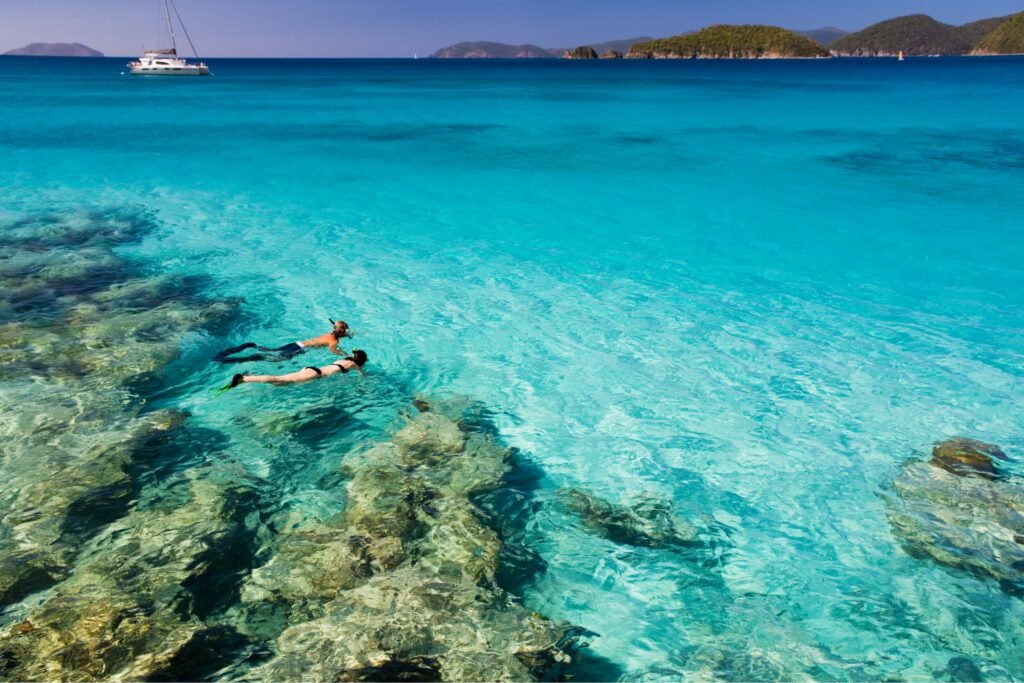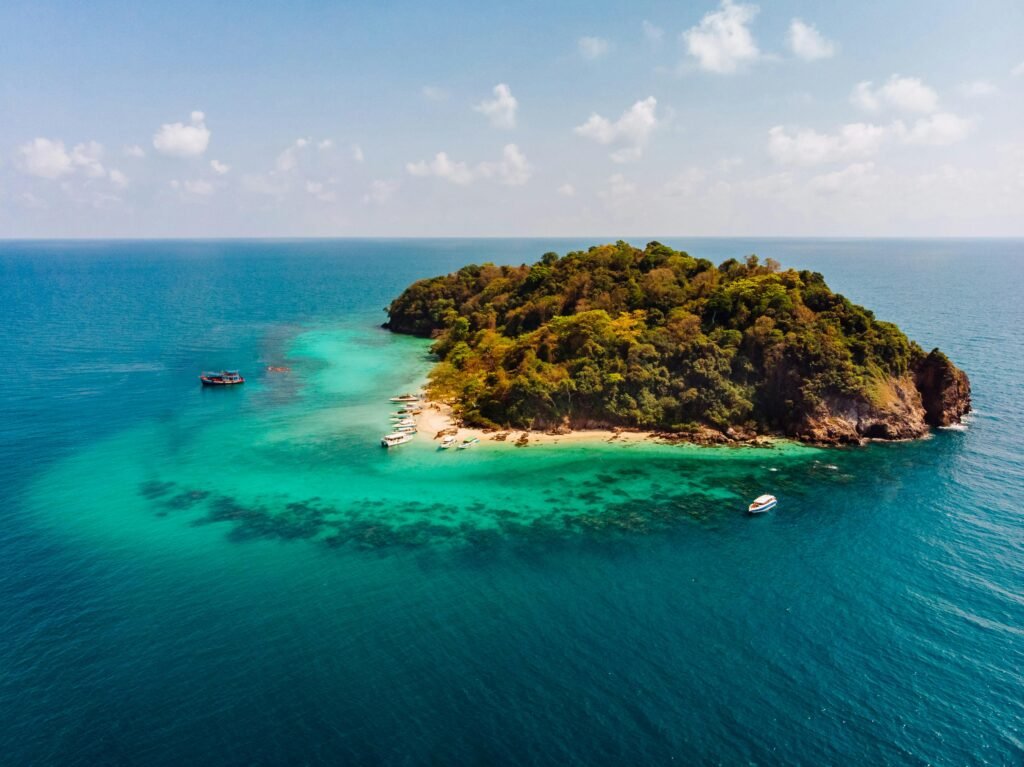The Caribbean Sea shimmers with a promise of adventure, its crystal-clear waters beckoning divers and snorkelers to a realm of vibrant reefs, fascinating shipwrecks, and a kaleidoscope of marine life. Exploring the underwater wonders of the Caribbean is a bucket-list experience for anyone who thrills to the beauty of the ocean’s depths. From beginner-friendly sites bursting with colorful fish to deep walls teeming with sharks, the Caribbean offers underwater treasures for every experience level.
The perfect time to visit the Caribbean for diving varies depending on your destination. Still, the dry season (December to April) generally offers the top conditions with calmer seas and better visibility.

Top Diving Destinations in the Caribbean
The Caribbean is a vast region; narrowing down where to dive first can be daunting. Here are some of the most iconic dive destinations that showcase the Caribbean’s underwater marvels:
Cayman Islands:
Cayman Island is a trio of islands, Grand Cayman, Cayman Brac, and Little Cayman, which caters to divers of all experience levels.
- Grand Cayman: World-famous for Stingray City, a shallow sandbar where divers can interact with gentle giant stingrays. The Kittiwake Wreck, a former naval freighter intentionally sunk in 1997, offers a unique and exciting wreck exploration opportunity for experienced divers.
- Little Cayman and Cayman Brac: These smaller islands are havens for wall diving enthusiasts. Bloody Bay Wall on Little Cayman boasts a sheer coral wall plunging over 1,000 feet, teeming with colorful fish life and more giant pelagic creatures.
Bonaire:
Nicknamed “Shore Diving Capital of the World,” Bonaire offers incredible accessibility for divers. Its entire coastline falls within a protected marine park, with numerous dive sites accessible directly from the shore. This makes Bonaire ideal for independent divers and those who prefer a relaxed diving experience. The underwater world boasts healthy coral formations teeming with fish life, even in shallow depths.
Barbados:
Carlisle Bay is a diver’s paradise in Barbados. You’ll find numerous shipwrecks resting within recreational diving depths, encrusted with vibrant coral and teeming with marine life. The wrecks, like the Bermudan ship “The Fairmont Bermudiana,” offer a fascinating glimpse into maritime history while providing a haven for various fish species.
Turks and Caicos:
Providenciales and West Caicos in Turks and Caicos are renowned for their dramatic coral walls. These walls plummet thousands of feet into the abyss, attracting a wider variety of marine life, including larger pelagic fish like sharks and tuna. Experienced wall divers will find these sites exhilarating, with incredible drop-offs and diverse marine encounters.
Bahamas:
The Bahamas caters to divers seeking a variety of underwater adventures.
- Shark Encounters: Tiger Beach in the Bahamas is a world-famous location where tiger sharks can be encountered in their natural habitat. These dives are conducted under professional guidance, ensuring safety and an unforgettable experience.
- Blue Holes: The Bahamas is home to the legendary Great Blue Hole, a vertical underwater cave system believed to be the deepest sinkhole in the world. While technical diving is required to explore its depths, recreational divers can marvel at the sheer scale of this geological marvel.
- Vibrant Reefs: The Bahamas boasts numerous healthy coral reefs throughout its archipelago. These reefs provide essential habitat for various fish life, from tiny colorful reef fish to larger predators.
This is just a selection of the many incredible dive destinations in the Caribbean. Each island offers unique underwater experiences, making the Caribbean a diver’s paradise.
What Kind of Marine Life Will You See in the Caribbean?
The Caribbean islands are a vibrant tapestry of marine life, with a dazzling array of creatures that will leave you breathless. Here’s a glimpse of some of the fascinating inhabitants you might encounter:
Sea Turtles:
Glide alongside majestic hawksbill turtles or loggerheads grazing on seagrass meadows. These gentle giants are a constant reminder of the ocean’s ancient wonders.

Colorful Reef Fish:
Schools of colorful fish like angelfish, butterflyfish, and parrotfish flit amongst the coral formations. Their vibrant hues and unique shapes add a touch of whimsy to the underwater world.
Rays:
Keep an eye out for graceful stingrays gliding effortlessly across the sandy bottom. In specific locations like Stingray City in the Cayman Islands, you may have the chance to interact gently with these fascinating creatures.
Moray Eels:
Peek into coral crevices to spot moray eels with their snake-like bodies and watchful eyes. While some may find them intimidating, these eels are pretty shy and play an essential role in the reef ecosystem.
Sharks:
The Caribbean boasts a healthy shark population, with reef, nurse, and even tiger sharks (in specific areas like the Bahamas) calling these waters home. Shark dives under professional guidance are an exhilarating experience, allowing you to witness these magnificent creatures in their natural habitat.
This is just a taste of the incredible diversity that awaits you in the Caribbean. Keep an eye out for:
Dolphins:
Bottlenose dolphins are occasionally spotted in some areas, adding a playful touch to your dive.
Bioluminescent Plankton:
Take a night dive in specific locations (like Vieques in Puerto Rico) to witness the magical phenomenon of bioluminescent plankton illuminating the water with an ethereal glow.

The sheer variety and abundance of marine life in the Caribbean will leave you mesmerized. With every dive, there’s a chance to encounter something new and awe-inspiring.
Planning Your Trip
Transforming your dream Caribbean dive adventure into reality requires some careful planning. Here are a few key aspects to consider:
Perfect Time to Dive the Caribbean:
- The dry season (generally December to April) offers the calmest seas, the top visibility, and the most agreeable weather.
- Shoulder seasons (May-June and October-November) can still offer good conditions with fewer crowds.
- Hurricane season (June to November) varies in intensity across the Caribbean. While you might find good dive conditions and cheaper rates, you must be mindful of potential weather disruptions.
Packing List for Divers:
Alongside your usual beach vacation essentials, be sure to pack:
- Diving certification card (if you have one)
- Logbook
- Mask, fins, snorkel (even if renting, it’s perfect to have your own mask for fit)
- Dive computer
- Rashguard or dive skin for sun protection and warmth
- Reef-safe sunscreen
- Underwater camera (if desired)

Dive Operators and Resorts:
Research can make all the difference in finding the right experience.
- Consider your experience level (are you a beginner or looking for advanced sites?)
- Check reputable dive organizations like PADI for recognized dive shops.
- Look for resorts that cater to divers, often offering on-site facilities and boat access.
- Read online reviews from other divers for firsthand experiences.
Responsible Diving and Conservation
The Caribbean’s vibrant reefs and marine life are precious resources. As divers and ocean enthusiasts, we are responsible for protecting these underwater treasures for future generations. Here’s how you can be an accountable diver:
- Practice Excellent Buoyancy:
Avoid touching or kicking corals, and maintain a neutral position in the water column. Bumping into corals can damage these delicate organisms.
- Don’t Chase or Harass Marine Life:
Maintain a safe distance and observe marine life without disturbing them. Avoid chasing fish or touching any underwater creatures.
- Take Only Pictures, Leave Only Bubbles:
Resist the temptation to take souvenirs from the reef. Everything you see plays a role in the delicate ecosystem.
- Be a Reef-Safe Consumer:
Choose reef-safe sunscreen, which omits chemicals harmful to corals. Look for eco-friendly accommodations and tour practices.
- Support Conservation Efforts:
Consider donating to organizations dedicated to marine conservation efforts in the Caribbean or volunteering for reef cleanups.
Sustainable Tourism:
- Seek out dive operators committed to sustainable practices. Look for businesses that educate divers on minimizing their impact on the underwater environment.
- Choose smaller, locally-owned dive resorts that prioritize eco-conscious practices.
By practicing responsible diving, you help ensure the health and beauty of the Caribbean’s reefs for years.
Photography Tips for Underwater Wonders
Capturing the vibrancy and beauty of the Caribbean’s underwater world is exhilarating. Here are some tips for divers wanting to improve their underwater photography:
Basic Equipment:
- Waterproof camera or housing: Even a point-and-shoot in waterproof housing can produce great results on sunny days. Dedicated underwater cameras or DSLRs with waterproof housings are ideal for more serious photographers.
- Strobe or underwater light: Artificial light helps restore colors and improve clarity in your photos, especially as you delve deeper.
Settings and Composition:
- Get close: Water reduces visibility, so getting closer to your subjects will produce sharper, more colorful images.
- Shoot upwards: Silhouetting marine life against the sunlit surface creates dramatic shots.
- Experiment with angles: Try shooting from below, looking upwards for dynamic perspectives.
Additional Tips:
- Practice buoyancy: Good buoyancy control will help you stay steady and avoid stirring up the seabed, which can cloud your photos.
- Start simple: Begin with significant, slow-moving subjects, like turtles, in bright lighting conditions.
- Take online courses: There are excellent resources dedicated to underwater photography, offering more advanced tips and techniques.
Remember, even a few simple photos can create lasting memories of Caribbean diving adventures!
Conclusion
The Caribbean Sea is a paradise of life, color, and adventure. From the vibrant reefs buzzing with activity to the silent grandeur of shipwrecks, endless wonder awaits divers of all levels. By planning mindfully, diving responsibly, and snapping a few photos along the way, your Caribbean dive trip will be an unforgettable journey into the beating heart of the ocean.
FAQs
Q: Is the Caribbean suitable for snorkeling?
A: Absolutely! The Caribbean offers fantastic snorkeling opportunities. Many of the top dive sites also have shallow, sunlit sections teeming with marine life, making them perfect for snorkelers. Look for islands like Bonaire or the Cayman Islands, where calm, protected waters and abundant wildlife make for unforgettable snorkeling experiences.
Q: What is the perfect time of year to go diving in the Caribbean?
A: The perfect time for diving in the Caribbean is generally the dry season (December to April), when you’ll find the calmest seas, most transparent water, and most pleasant weather conditions. However, many parts of the Caribbean offer good conditions year-round, so researching your desired destination for specific seasonal variations is worth exploring.
Q: What can I expect to see in the Caribbean?
A: The sheer diversity of marine life in the Caribbean will delight you! Expect colorful reef fish, sea turtles, graceful rays, potential dolphins, schools of vibrant fish, and various corals and sponges. Specific locations may also boast more giant creatures like sharks or unique underwater features like shipwrecks.
Q: Do I need to be certified for scuba diving in the Caribbean?
A: You don’t need prior certification to try scuba diving. Most dive operators offer “Discover Scuba Diving” experiences. These allow you to try scuba diving under the close supervision of an instructor, usually within a pool or calm, shallow dive site. If you enjoy it, you can pursue an entire certification course.
Q: Is the Caribbean safe for diving?
A: The Caribbean is generally considered a safe region for diving. However, it’s crucial to choose reputable dive operators, always follow your dive guide’s instructions, and stay within the limits of your experience level. Respecting the ocean environment and marine life will help ensure a safe and enjoyable experience.


